FEM Simulation on First-Step Drawing Process of Platinum-Clad Nickel Bars
Abstract
:1. Introduction
2. Materials and Methods
Geometrical Model
- (1)
- The drawing dies were assumed to be rigid materials, and platinum tube and nickel bar were assumed to be plastic materials.
- (2)
- Platinum tube and nickel bar were assumed to be axisymmetric and did not have any defects. One quarter of the cross-section of the platinum tube, nickel bar and drawing die are selected to build the model for analysis.
- (3)
- The materials follow an isotropic hardening flow rule.
- (4)
- The drawing die is simplified into four areas: lubrication cone, work cone, calibrating strap and exit cone.
3. Simulation Results and Analysis
3.1. The Effect of α and T on Drawing Load
3.2. The Effect of α and T on Equivalent Stress
3.3. The Effect of α and T on Axial Equivalent Stress Distribution
3.4. The Effect of α and T on Radial Equivalent Stress Distribution
3.5. The Effect of α and T on Cladding Condition
3.6. The Effect of α and T on Damage
4. Confirmation Experiment
5. Conclusions
- (1)
- The influence of semi-angle on first-step drawing process: The drawing load tends to decrease and the damage value increases with the increase in semi-angle, while the semi-angle has little effect upon the equivalent stress on the platinum tube. Therefore, in order to minimize damage to the platinum tube, a smaller semi-angle (3°) should be used.
- (2)
- The influence of wall thickness of platinum tubes on first-step drawing process: The drawing load increases with the increase in the wall thickness of the platinum tubes, as does the equivalent stress and the damage value on the platinum tube. Therefore, a smaller wall thickness of platinum tubes (0.275 mm) should be used.
- (3)
- After first-step drawing, there are still gaps between the platinum tube and the nickel bar. When the platinum tube is thick, due to the high pulling force, it will cause secondary separation between the platinum layer and the nickel rod, which will cause more serious damage to the platinum tube. Therefore, a smaller wall thickness of platinum tubes (0.275 mm) should be used.
Author Contributions
Funding
Data Availability Statement
Conflicts of Interest
References
- Bhadrakali, A.S.; Ramasastry, D.V.A.; Prabhu, T.R.; Kumar, C.B.; Kumar, K.R.; Muralimohan, C. Microstructure and Mechanical Properties of the Bimetallic Wire Arc Additively Manufactured Structure (BAMS) of SS304L and SS308L Fabricated by Hybrid Manufacturing Process. Trans. Indian Inst. Met. 2022, 76, 419–426. [Google Scholar]
- Alireza, D.; Alain, G.; Clément, K.; Benoit, V. Metal Forming-Induced Residual Stresses and Rule of Mixtures’ Prediction of Tensile Behavior of Bimetallic Wires. Key Eng. Mater. 2022, 6392, 381–388. [Google Scholar]
- Irina, V.; Natalia, V.; Roman, F.; Alexandr, K. Hardening of Bimetallic Wires from Secondary Materials Used in the Construction of Power Lines. Materials 2022, 15, 3975. [Google Scholar]
- Li, H.J.; Ding, Z.M.; Tan, F.L.; Liu, B.G. Microstructural Evolution and Mechanism of Grain Refinement During Annealing of Cold-Drawn Copper Clad Steel Wires. JOM 2020, 72, 2134–2138. [Google Scholar] [CrossRef]
- Münster, D.; Hirt, G. Copper Clad Steel Strips Produced by a Modified Twin-Roll Casting Process. Metals 2019, 9, 1156. [Google Scholar] [CrossRef] [Green Version]
- Zhang, Z.Q.; Wu, F.Y.; Liu, Z.; Tu, Z.; He, K.l. Study on corrosion mechanism of shielding line of copper clad aluminum cable in substation terminal box. IOP Conf. Ser. Earth Environ. Sci. 2019, 310, 32018. [Google Scholar] [CrossRef] [Green Version]
- Moisy, F.; Gueydan, A.; Sauvage, X.; Guillet, A.; Keller, C.; Guilmeau, E.; Hug, E. Influence of intermetallic compounds on the electrical resistivity of architectured copper clad aluminum composites elaborated by a restacking drawing method. Mater. Des. 2018, 155, 366–374. [Google Scholar] [CrossRef]
- Hasanniah, A.; Movahedi, M. Welding of Al-Mg aluminum alloy to aluminum clad steel sheet using pulsed gas tungsten arc process. J. Manuf. Process. 2018, 31, 494–501. [Google Scholar] [CrossRef]
- Rahimi, S.; Movahedi, M. Resistance Spot Welding of Aluminum to Aluminum Clad Steel Sheet: Experimental and Theoretical Analysis. J. Manuf. Process. 2020, 58, 429–435. [Google Scholar] [CrossRef]
- Shi, B.B.; Liu, X.H.; Xie, J.X.; Xie, M. Preparation process of silver clad aluminum bars by vertical continuous casting composite forming. Chin. J. Eng. 2019, 41, 633–645. [Google Scholar]
- Yin, J.M.; Liu, Y.; Zhang, G.Q.; Wu, H.J.; Qin, Q.Y.; Zhu, W.X.; Wan, J.G.; Pu, E.X. Study on Preparation Process of Low Density and Ultrafine Silver Clad Aluminum Composite Soft Wire. Precious Met. 2020, 41, 65–69. [Google Scholar]
- Du, W.J.; Xie, M.; Pu, C.J.; Yang, Y.F.; Liu, H.J.; Zhang, J.M.; Chen, Y.T.; Liu, M.M.; Hu, J.Q.; Wang, S.B. Effect of Annealing Temperature on Interface and Mechanical Properties of Silver Clad Copper Wires. Rare Met. Mater. Eng. 2015, 44, 452–456. [Google Scholar]
- Kang, F.F.; Kong, J.W.; Chen, J.L.; Zhou, W.Y.; Yang, G.X.; Pei, H.Y. Enhancement of Mechanical Properties of Gold-Coated Silver Composite Bonding Wire with Palladium and Copper Elements Addition. Chin. J. Rare Met. 2019, 43, 1302–1308. [Google Scholar]
- Kang, F.F.; Zhou, W.Y.; Wu, Y.J.; Yang, G.X.; Kong, J.W.; Pei, H.Y. Microstructure and Properties of Gold-Coated Silver Composite Bonding Wire for Microelectronic Package. Semicond. Technol. 2018, 43, 702–707. [Google Scholar]
- Chang, C.Y.; Hung, F.Y.; Lui, T.S. Mechanical and Electrical Properties of Palladium-Coated Copper Wires with Flash Gold. J. Electron. Mater. 2017, 46, 4384–4391. [Google Scholar] [CrossRef]
- Du, Y.H.; Liu, Z.Q.; Ji, H.J.; Li, M.Y.; Wen, M. The mechanism of Pd distribution in the process of FAB formation during Pd-coated Cu wire bonding. J. Mater. Sci. Mater. Electron. 2018, 29, 13774–13781. [Google Scholar] [CrossRef]
- Yang, Y.K.; Yan, X.F.; Huang, G.L.; Bai, X.P. Manufacturing of Platinum-Nickel 30/70 Compound Wires. Electr. Mater. 2006, 1, 6–9+13. [Google Scholar]
- Lou, M.X.; Liu, X.H.; Jiang, Y.B.; Xie, J.X.; Xie, M. Rotary swaging-drawing formation, microstructure, and properties of copper-clad aluminum composite micro-wires. Chin. J. Eng. 2018, 40, 1358–1372. [Google Scholar]
- Sun, D.; Wang, Z.; Jiang, S.Y.; Zhang, Y.Q. Interface Compatibility During Different-Temperature Cu/NbTi Cladding Extrusion: Simulation and Experiment. Rare Met. Mater. Eng. 2023, 52, 441–447. [Google Scholar]
- Zhao, Y.; Song, B.Y.; Pei, J.Y.; Yun, X.B. Study on Metal Flow in Continuous Extrusion Cladding of Cable Aluminum Sheath Using FEM Analysis. Adv. Mater. Res. 2011, 1165, 1934–1940. [Google Scholar] [CrossRef]
- Li, H.J.; Tan, F.L.; Liu, B.G.; Wu, J.W. Study on Microstructure and Mechanical Properties of Copper Clad Steel Wire Prepared by Solid Phase Rolling Composite Method. Hot Work. Technol. 2020, 49, 86–89. [Google Scholar]
- Su, Y.J.; Liu, X.H.; Huang, H.Y.; Liu, X.F.; Xie, J.X. Interfacial Microstructure and Bonding Strength of, Copper Cladding Aluminum Rods Fabricated by Horizontal Core-Filling Continuous Casting. Metall. Mater. Trans. 2011, 42, 4088–4099. [Google Scholar] [CrossRef]
- Pilone, D.; Mondal, A.; Zortea, L. High-Temperature Oxidation Behaviour of a TiAl-Based Alloy Subjected to Aluminium Hot-Dipping. Oxid. Met. 2022, 98, 529–543. [Google Scholar] [CrossRef]
- Tran, T.Q.; Lee, J.K.Y.; Chinnappan, A.; Jayathilaka, W.A.D.M.; Ji, D.X.; Kumar, V.V.; Ramakrishna, S. Strong, lightweight, and highly conductive CNT/Au/Cu wires from sputtering and electroplating methods. J. Mater. Sci. Technol. 2020, 40, 99–106. [Google Scholar] [CrossRef]
- Osman, N.; Sajuri, Z.; Omar, M.Z. Multi-pass friction stirred clad welding of dissimilar joined AA6061 aluminium alloy and brass. J. Mech. Eng. Sci. 2018, 12, 4285–4299. [Google Scholar] [CrossRef]
- Duan, X.W.; Wang, M.; Che, X.; He, L.F.; Liu, J.C. Cellular automata coupled finite element simulation for dynamic recrystallization of extruded AZ80A magnesium alloy. J. Mater. Sci. 2023, 58, 1345–1367. [Google Scholar] [CrossRef]
- Soumyaranjan, N.; Abhishek, K.S.; Hina, G.; Prasad, M.J.N.V.; Narasimhan, K. Optimization of Ti-6Al-4V ring rolling process by FE simulation using RSM. Int. J. Solids Struct. 2023, 262–263, 112064. [Google Scholar]
- Shi, J. The Study on the Numerical Simulation On Clad-Drawing and the Performance of Copper Clad Aluminum. Master’s thesis, Jiangsu University, Zhenjiang, China, 2011. [Google Scholar]
- Xiang, Y.Y. Numerical Simulation of Continuous Extrusion Cladding and Synchronous Drawing Process and Study on Microstructure and Properties of Aluminum-Clad Steel Wire. Master’s thesis, Hefei University of Technology, Hefei, China, 2021. [Google Scholar]
- Yang, M.X.; Luan, J.T.; Zhou, T.G.; Zhang, X.F. Computer Simulation of Aluminum Conductors Drawn in High Speed. Adv. Mater. Res. 2013, 834–836, 1567–1570. [Google Scholar] [CrossRef]
- Chen, Y.T.; Chong, X.Y.; Zhao, S.Q.; Yang, Y.C.; Li, A.K.; Fang, J.H.; Hu, J.Q.; Xie, M. Optimization of the First-Step Drawing Parameters for Platinum-Clad Nickel Bar Based on FEM Simulation. Metals 2023, 13, 1201. [Google Scholar] [CrossRef]
- Ning, Y.T.; Yang, Z.F.; Wen, F. Platinum; Metallurgical Industry Press: Beijing, China, 2010. [Google Scholar]
- Zhu, G.H.; Xiao, H.F.; Sui, F.L. Flow Stress Model of Pure Al/Ni for Cold Deformation and Its Application. J. Anhui Univ. Technol. (Nat. Sci.) 2011, 28, 205–209. [Google Scholar]


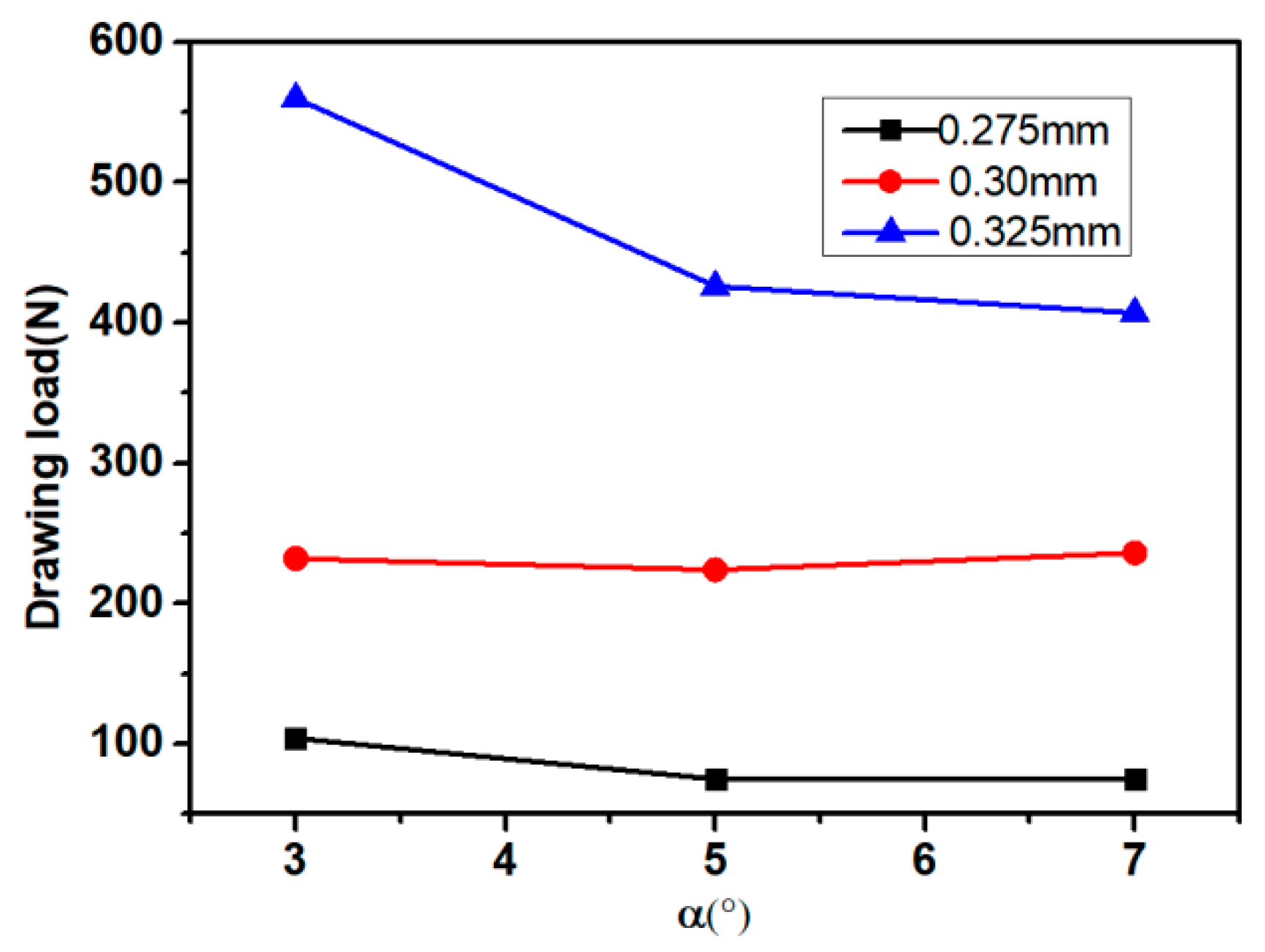
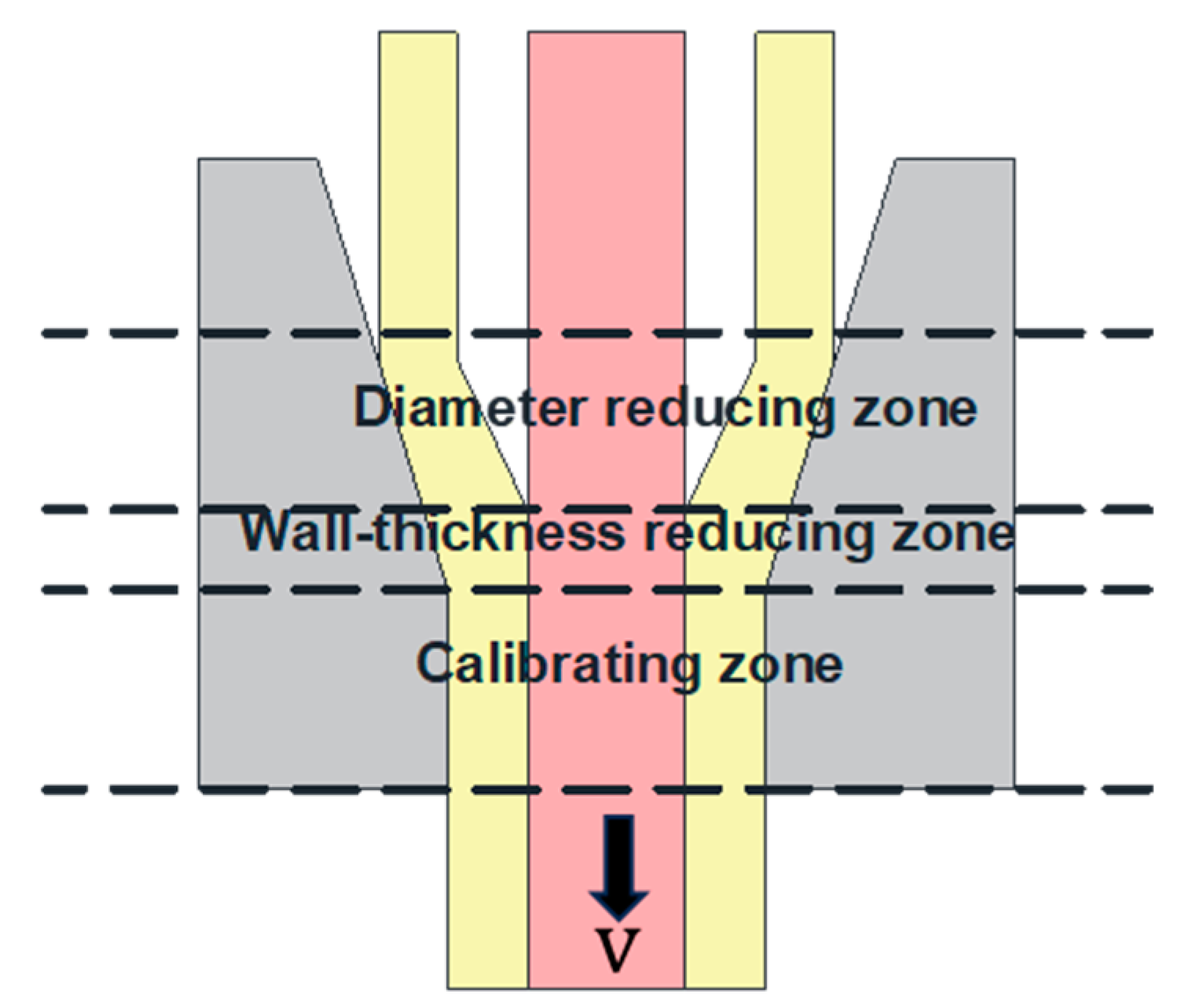
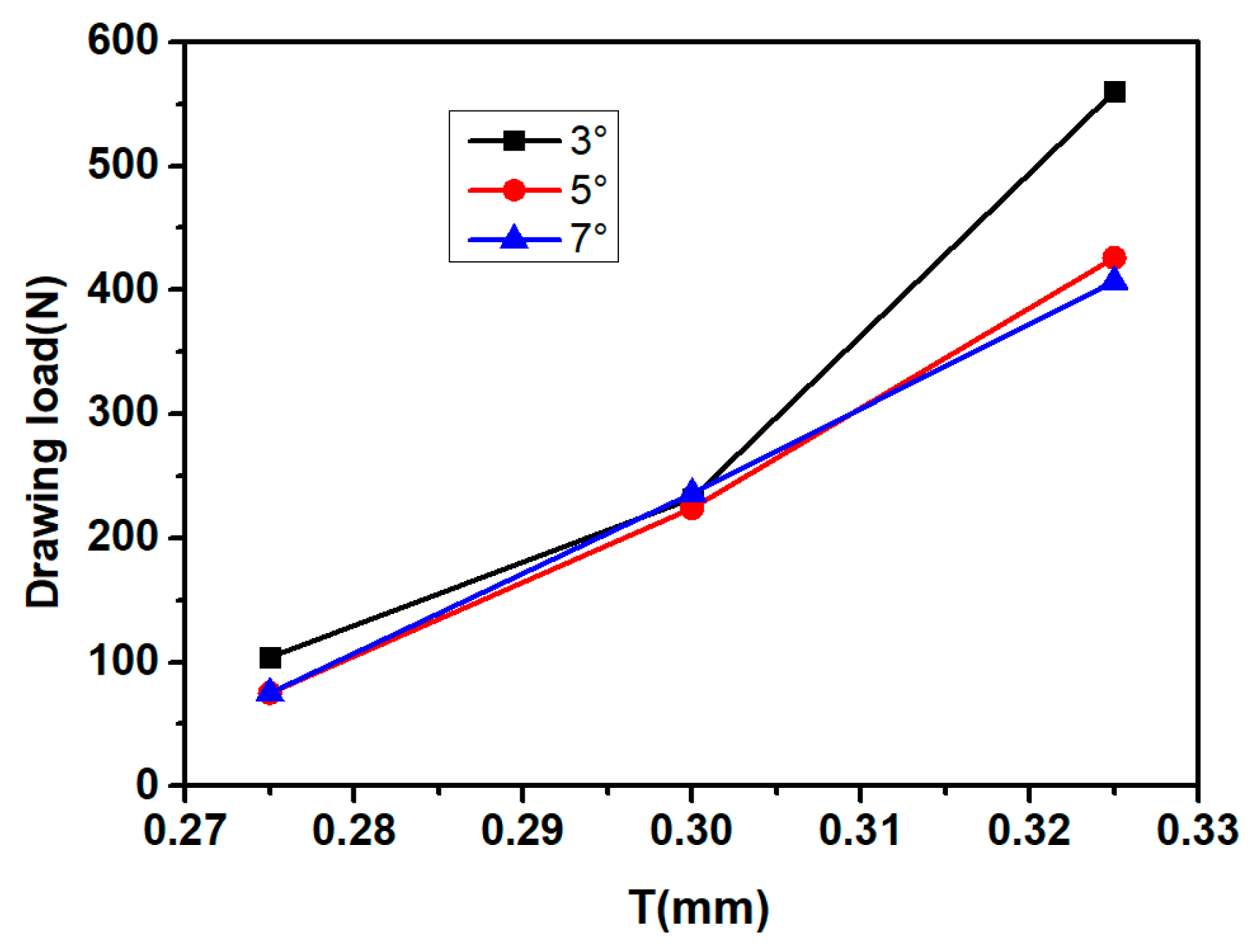
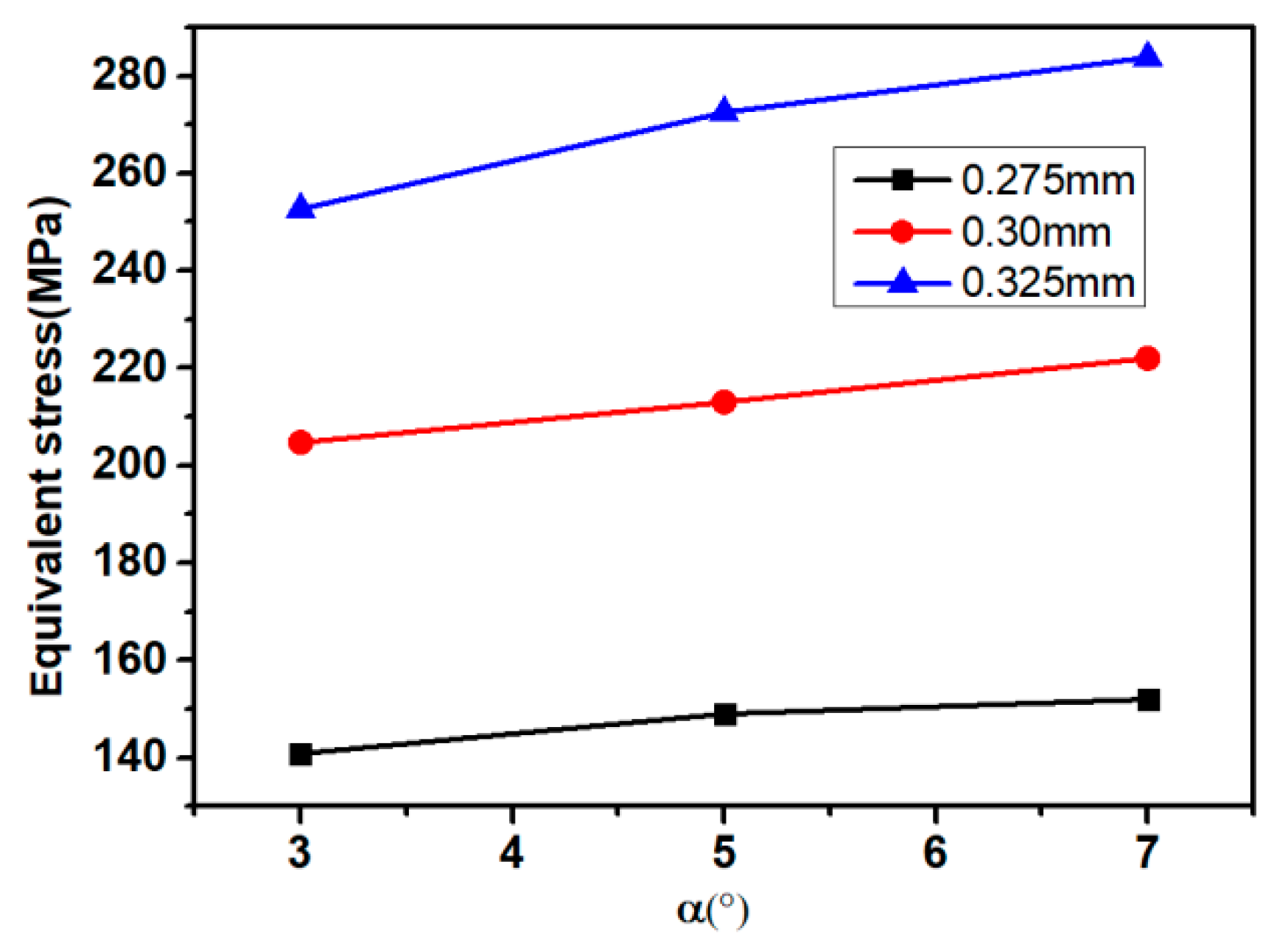





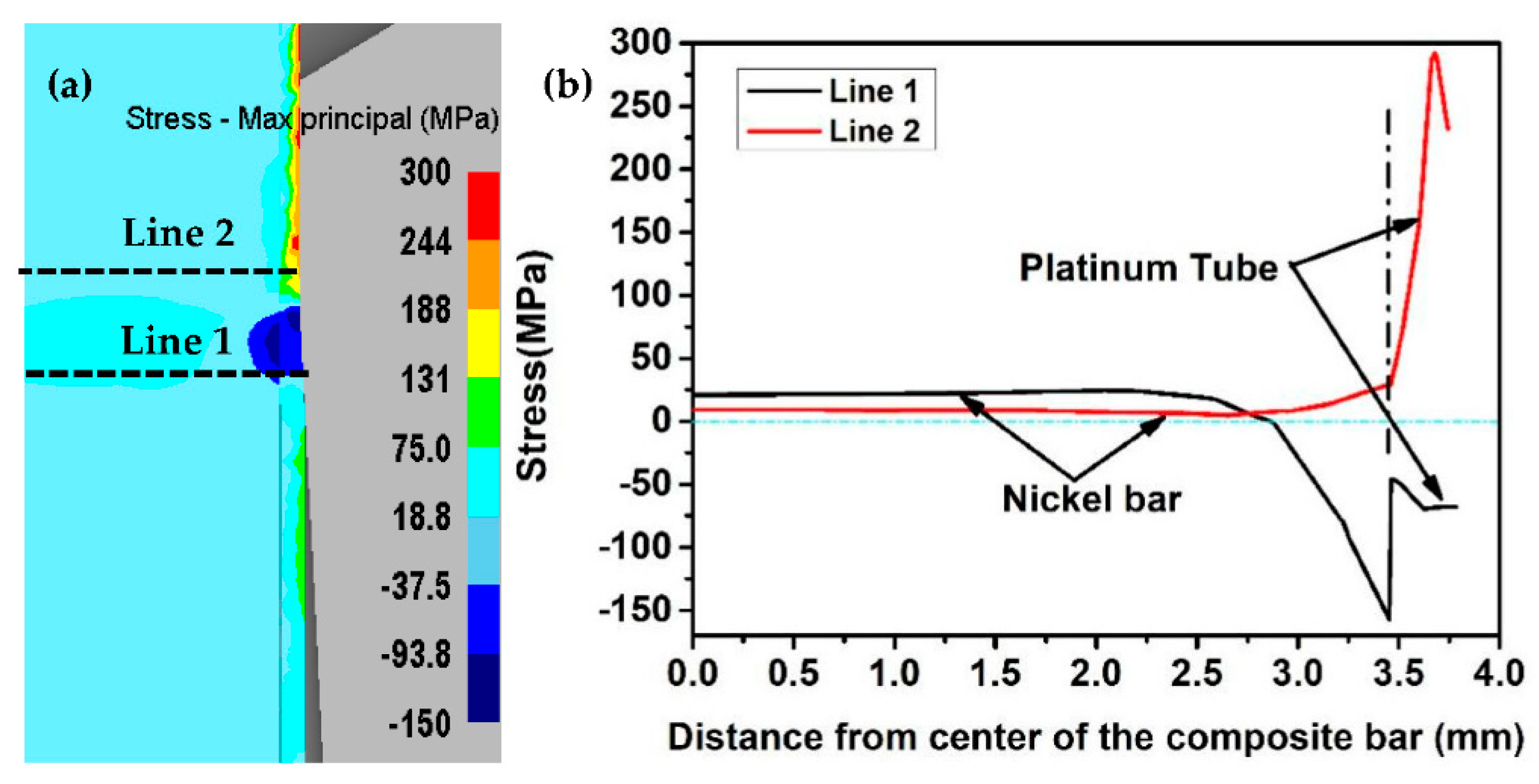
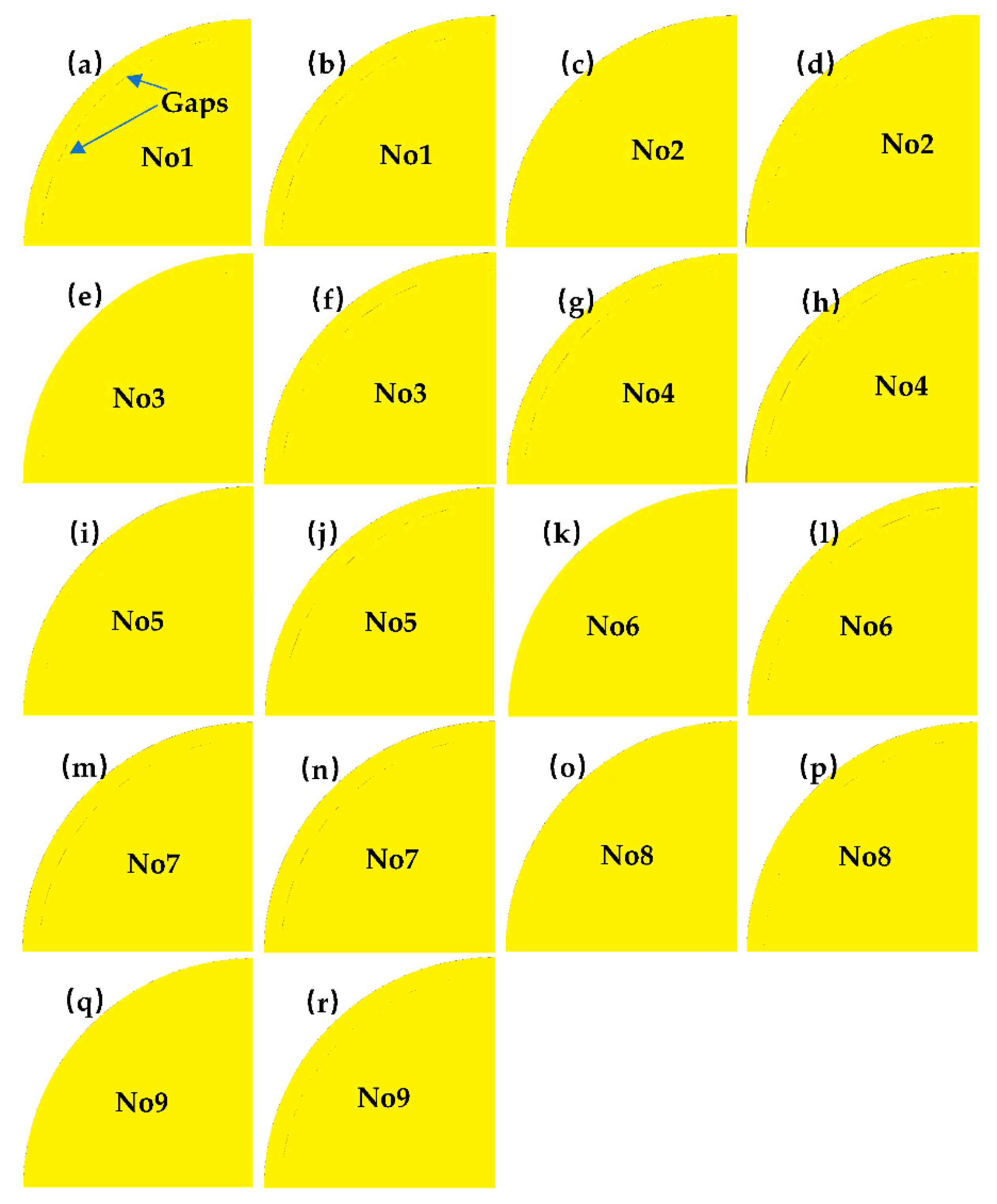



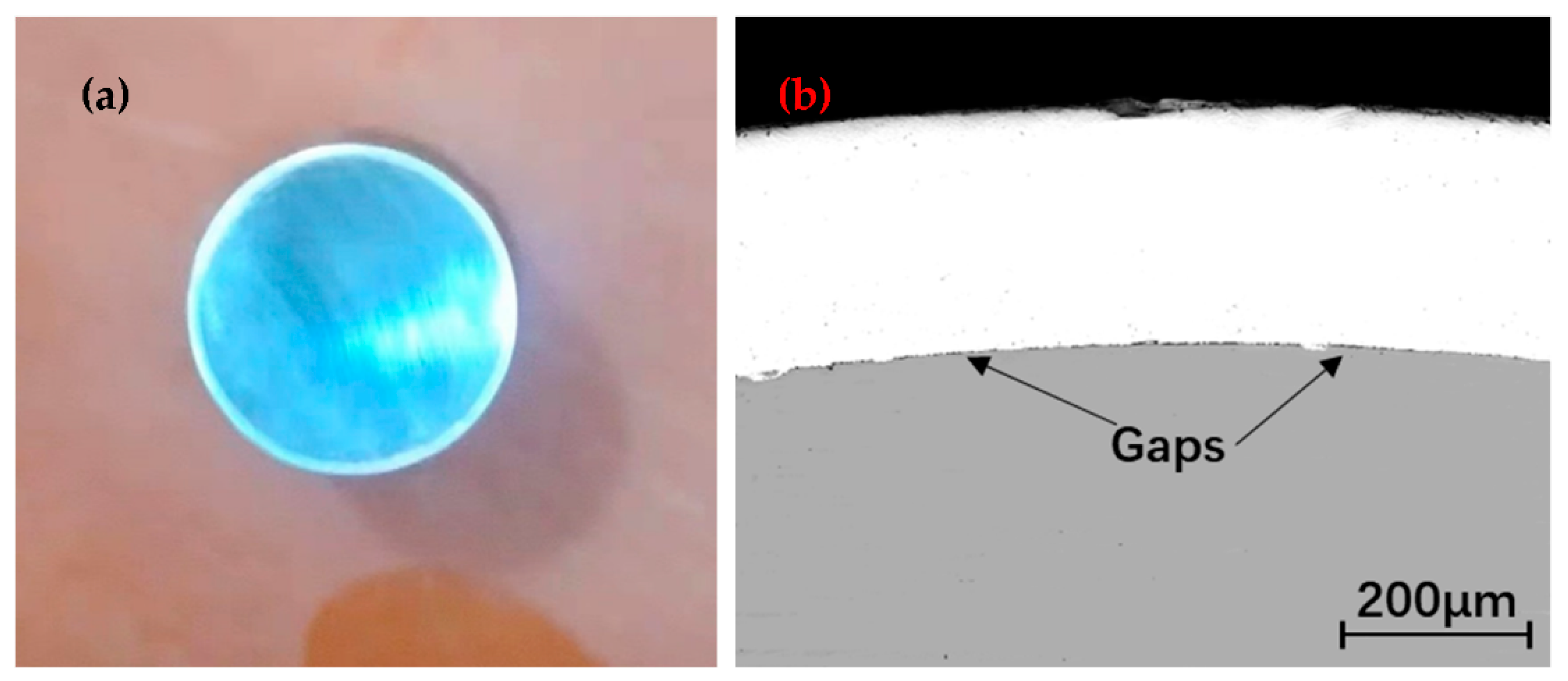
| Forming Conditions | |||
|---|---|---|---|
| Diameter of the nickel bar, Dn[mm] | 6.95 | ||
| Inner diameter of the platinum tube, Di[mm] | 7.00 | ||
| The thickness of the original platinum tube wall, T[mm] | 0.275, 0.300, 0.325 | ||
| Calibrating strap diameter, Dc[mm] | 7.50 | ||
| Calibrating strap length, [mm] | 3 | ||
| Semi-angle of the die, | 3, 5, 7 | ||
| Drawing speed, ν [mm/s] | 5 | ||
| The friction between the platinum tube and the die, μ1 | 0.2 | ||
| The friction between the platinum tube and the die, μ2 | 0.3 | ||
| Material conditions | |||
| Material conditions | Platinum tube | Nickel bar | Drawing die |
| Material | Platinum | Nickel | AISI H13 |
| Object type | Plastic | Plastic | rigid |
| Young’s modulus, E [GPa] | 169 | 207 | - |
| Poisson’s ratio, | 0.334 | 0.31 | - |
| Power law [MPa] | [32] | [33] | - |
| Number of elements | 80,000 | 50,000 | - |
| Simulation Experiment Number | Semi-Angle (α) | Thickness of Platinum Tube Wall (T) |
|---|---|---|
| ° | mm | |
| 1 | 3 | 0.275 |
| 2 | 3 | 0.300 |
| 3 | 3 | 0.325 |
| 4 | 5 | 0.275 |
| 5 | 5 | 0.300 |
| 6 | 5 | 0.325 |
| 7 | 7 | 0.275 |
| 8 | 7 | 0.300 |
| 9 | 7 | 0.325 |
| Materials | Inner Diameter/mm | Wall Thickness/mm | Diameter/mm | Length/mm | Number |
|---|---|---|---|---|---|
| Platinum tube 1 | 7.0 | 0.278 | - | 12.5 | 1 |
| Platinum tube 2 | 7.0 | 0.32 | - | 12.5 | 1 |
| Nickel bar | - | - | 6.95 | 25 | 2 |
Disclaimer/Publisher’s Note: The statements, opinions and data contained in all publications are solely those of the individual author(s) and contributor(s) and not of MDPI and/or the editor(s). MDPI and/or the editor(s) disclaim responsibility for any injury to people or property resulting from any ideas, methods, instructions or products referred to in the content. |
© 2023 by the authors. Licensee MDPI, Basel, Switzerland. This article is an open access article distributed under the terms and conditions of the Creative Commons Attribution (CC BY) license (https://creativecommons.org/licenses/by/4.0/).
Share and Cite
Chen, Y.; Yang, M.; Hu, J.; Zhang, J.; Yang, Y.; Xie, M. FEM Simulation on First-Step Drawing Process of Platinum-Clad Nickel Bars. Metals 2023, 13, 1462. https://doi.org/10.3390/met13081462
Chen Y, Yang M, Hu J, Zhang J, Yang Y, Xie M. FEM Simulation on First-Step Drawing Process of Platinum-Clad Nickel Bars. Metals. 2023; 13(8):1462. https://doi.org/10.3390/met13081462
Chicago/Turabian StyleChen, Yongtai, Mingxiang Yang, Jieqiong Hu, Jiming Zhang, Youcai Yang, and Ming Xie. 2023. "FEM Simulation on First-Step Drawing Process of Platinum-Clad Nickel Bars" Metals 13, no. 8: 1462. https://doi.org/10.3390/met13081462




